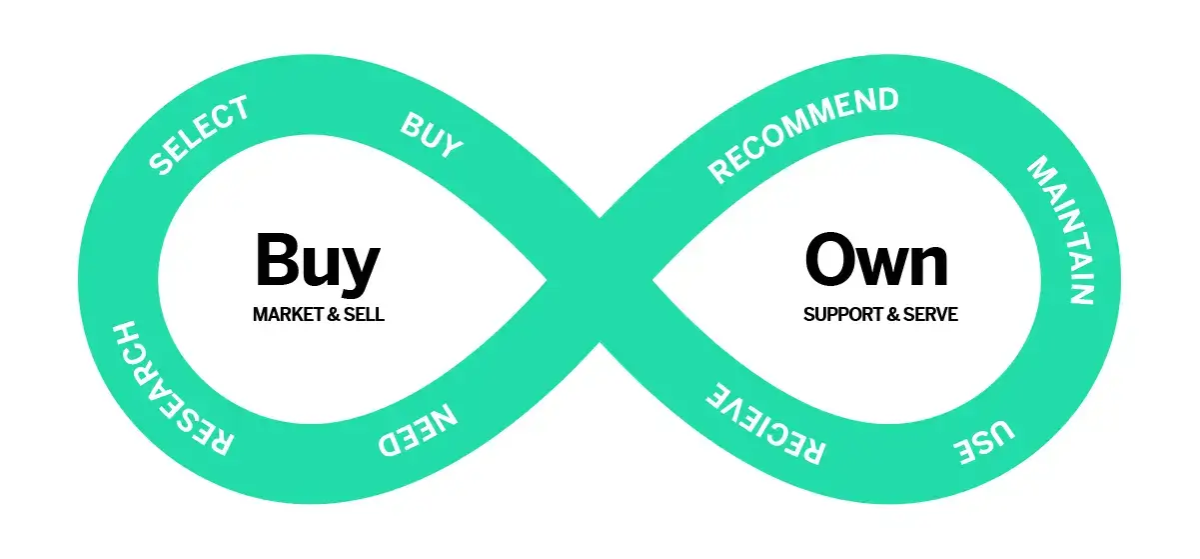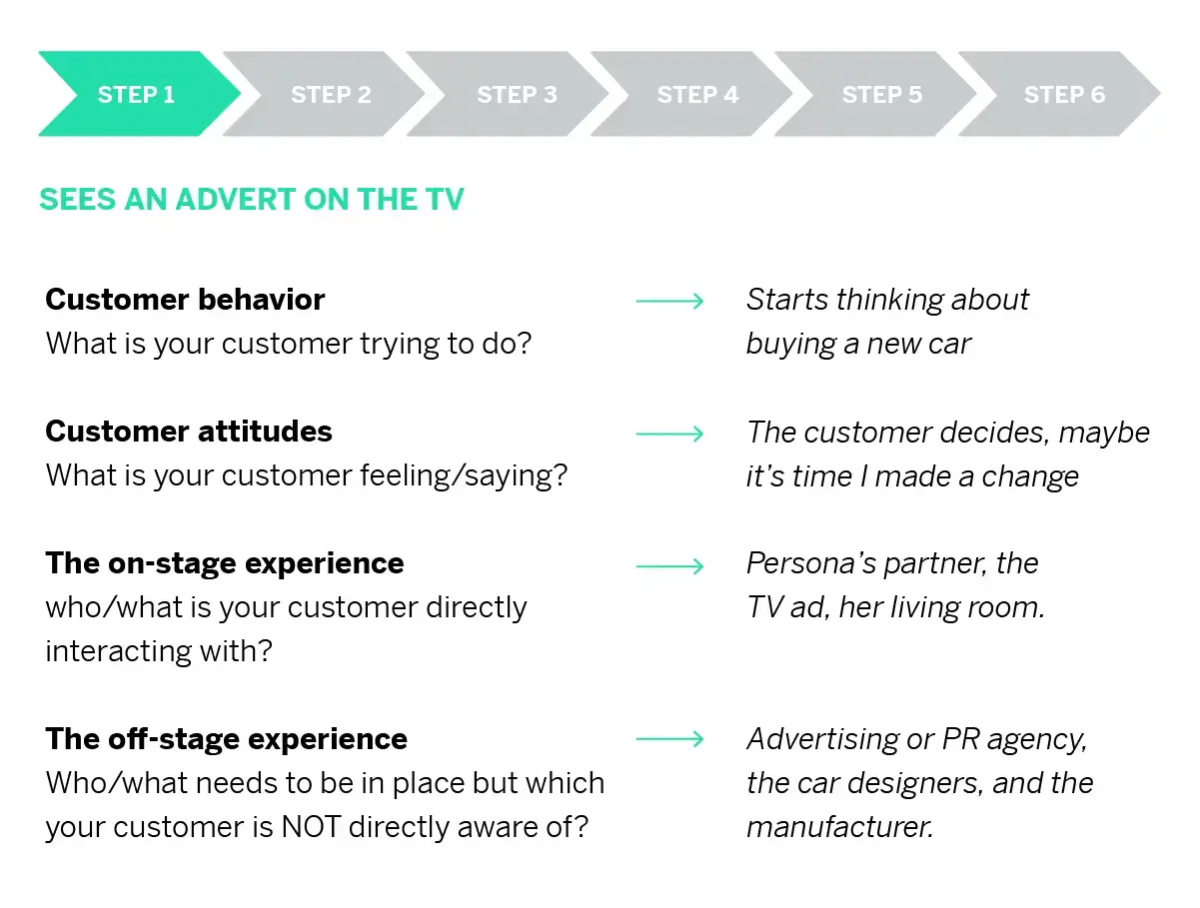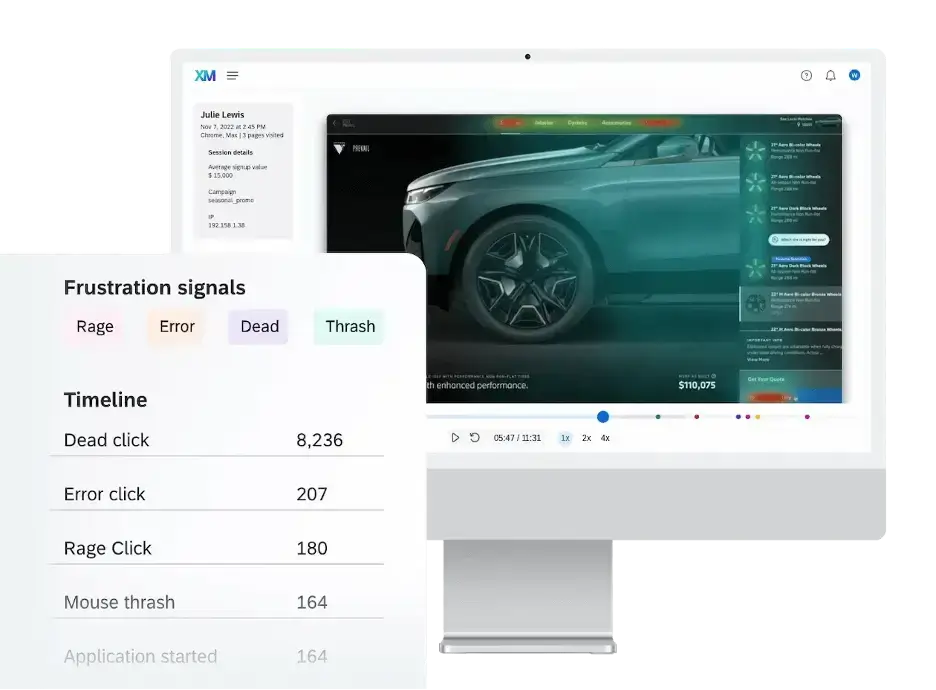Journey mapping is a central part of CX leadership. Done well, it helps businesses recognize customer pain points, find key areas of friction, and prioritize their efforts and investments. Sadly, you can’t fix everything at once – so how do you choose what to fix first? How do you prioritize?
Customer journey mapping zooms in on key moments of customer impact, and helps to define where you’ll get the biggest return on changes made to the experience.
What is customer journey mapping?
Customer journey mapping is a methodology for outlining the various routes customers take toward – and beyond – doing business with you.
A customer journey map is a visual representation of one such route; by joining multiple customer journey maps together, businesses can better understand their customers’ needs and perceptions before, during, and after any transaction or interaction.
Customer journey mapping helps shine a light on:
- How customers move from awareness through to purchase
- The touchpoints customers use along each journey
- The efficiency of the connections between each stage
- The health of the ongoing, post-sales relationship
- Pain points along each journey
Typically, journeys fall into one of four categories:
- Purchasing/delivery/onboarding
- Own/use
- Support/maintenance
- Renewal
A journey map, then, reflects the step-by-step experience a customer has as they move towards one of these goals.
Why use customer journey maps?
A customer journey map creates a common understanding for the organization of how customers interact during the different stages of the customer lifecycle – and the roles and responsibilities of the various teams in charge of fulfilling those experiences.
Customer journey mapping will also help bring an organization together and foster empathy and collaboration between teams to deliver the experiences that customers expect. Humans have always used storytelling to spread information, backing this up with visuals and data makes this mechanism even more powerful.

Continuous customer lifecycle
This, in turn, will help you develop a shared sense of ownership of the customer relationship, which ultimately drives a customer-centric culture.
Maximizing satisfaction with customer journeys has the potential not only to increase customer satisfaction by 20% but also lift revenue up by 15% while lowering the cost of serving customers by as much as 20%
– McKinsey, The Three Cs of Customer Satisfaction
What’s more, creating an accurate customer journey map will help your customer service team focus on more specific issues, rather than handling problems generated by a less-tailored customer journey. It’s so common for organizations to end up with a laundry list of ‘to-do’s’ – strong journey mapping will more rapidly identify the ‘must-do’s’ and prioritise efforts and investment into the moments that truly matter to the customer.
Your customer experience will be improved because you’ll be designing customer journeys that are more personalized to the specific personas you’ve generated. Journey mapping means putting yourself in your customers’ shoes and adapted your strategy to better reflect their perspective – which will naturally lead to more memorable experiences.
Creating a customer journey map will also influence your journey analytics and KPIs across the business. It will determine what, who, when, why, and how you ask questions in your Voice of the Customer Program.
Customer journey mapping use cases
If you want to improve your customer experience, you need to understand and adapt the customer journeys you offer. Whether a customer’s journey is entirely online, in person, or a blend of channels, there are multiple routes a customer might take.
So when should you use customer journey mapping? There are four general uses:
- Assess the current state of your customer journey: Understand and diagnose specific issues with current experiences
- Understand what your customer journey should look like: Design, redesign, and create new experiences
- Building blueprints: For implementing change and improvement
- Communication: Bringing teams together to train and scale up best practices.
Understanding the customer journey helps you identify and take action on customer pain points – and repeat what’s working. By doing this, you’ll improve the overall customer experience, which will drive better outcomes for your business.
Getting started with journey mapping
Creating a customer journey map means forming a visual representation of a customer’s processes, needs, and perceptions throughout their interactions and overarching relationship with your organization.
This helps you understand the steps customers take – the ones you see, and the ones you don’t – when they interact with your business, letting you assess the following:
- Insights: From your existing customer journey
- Issues: Diagnose what’s not quite working
- Innovation: Where do we need to completely overhaul the existing customer journey?
- Impact: How to optimize budgets and efforts for customer experience improvements
Many brands see the customer journey as something visible – where the customer tangibly interacts with the brand. In reality, this thinking only accounts for a tiny subset of the entire customer journey. So creating a customer journey map gets you thinking about the aspects of the journey you don’t see, but which have equal weight and importance to the entire experience.
Understanding the ‘Moments That Matter’
When mapping out the customer journey, you’re hunting for the moments that matter – those instances where there’s the greatest emotional load.
If you can make changes to how that moment is delivered, you’ll make an impact. If you mess things up at that moment, it doesn’t matter how good the rest of the journey was; that moment will be what customers remember.
Moment that matters: Example
If you’re buying a car, the greatest moment of emotional load is likely to be when you go to pick it up. You’ve chosen the model, picked the color, and are waiting for it to be ready… If, after all that anticipation, the new car is dusty, muddy or the dealership doesn’t have it ready when they said it would, then the disappointment in that moment will have a disproportionate impact on how you talk about your experience to people afterward.
Ensuring these moments match your customers’ expectations of your product, brand, and service teams is key to helping you reach your business goals. But you can only do that by understanding the journeys your customers go on in order to get there, and what they’re thinking and needing from you at that time. Customer journey mapping puts you in their shoes so you can understand them better than ever before.
Beginning your customer journey map
Creating a customer journey map template doesn’t have to be difficult, but it does need to cover several key elements in order to be effective.
Understanding customer behaviors and attitudes also means you can fix bad experiences more effectively because you’ll know why you haven’t met your customers’ expectations and what you’ll need to do to make amends.
There may be times when things go wrong, but it’s how you adapt and what you do to fix these experiences that makes all the difference. Knowing how the customer will be feeling makes taking that decisive action much easier.
What to assess when exploring the customer journey:
- Customer behavior: What is your customer trying to do?
- Customer attitudes: What is your customer feeling/saying?
- The on-stage experience: Who/what is your customer directly interacting with? (This includes various channels, such as TV ads or social media). People, processes, physical surroundings.
- The off-stage experience: Who/what needs to be in place but which your customer is NOT directly aware of? People, processes, physical surroundings.

What the start of a customer journey map could look like for the process of buying a car
Customer journey map templates
Start by choosing a journey you’d like to create a customer journey map for and try outlining the first step customers will take.
You can then use our free customer journey map template below to work out the customer behaviors, attitudes, the on-stage and off-stage processes – as well as the KPIs you’ll need to measure the success of each experience.
Download our free journey mapping template here
A step-by-step journey mapping process
The customer journey mapping process begins with the buyer persona, before exploring the possible routes and pathways they might take. Here are six steps to successful journey mapping…
Step 1. Create a customer persona to test
A persona is a fictional representation of a group of real customers – they allow us to think about our journeys in terms of what people’s goals, needs and desires are.
You may base a customer persona on your most common or regular customers, big spenders, or new customers you haven’t worked with before. This persona is not exactly the same as a marketing segment, but that can be a great place to begin if you’re just starting out on the mapping process.
Start with these characteristics.
- Name
- Age
- Job role
- Family status
- Professional goals
- Personal goals
- Known expectations for this product or service
These personas can be derived from insights and demographic data, your organization’s financial and operational data, your marketing team’s segmentation, or even customer interviews.
This works for both B2B and B2C business models, but with B2B you’ll often have multiple people involved in each opportunity. An example would be the primary user, their budget holder, and maybe someone from the customer’s procurement team. Each person may be involved through the entire journey, or only for some parts.
Either way, we suggest starting with no more than three personas to keep things simple.
Persona examples:
A holiday company might have two main personas:
- Isabel travels with her partner, loves to indulge in luxury travel, and loves to explore. She wants to hear about new destinations and go off the beaten track.
- Sophie travels with her family. It’s really important that she can keep everyone entertained and avoid lengthy, complicated journeys. She likes to find fun trips during school holidays and might focus on self-contained resorts.
Already we can see that each of those personas represents customers with certain needs – and that their goals are quite different. But they’re both easy to refer to as a shorthand when we’re looking at journeys. A persona should feel like a real person, even though they are a representative of a group of customers.
Step 2. Choose a customer journey for mapping
Select a customer journey map to construct, then build a behavior line. This might be a new customer journey, a renewal, or fixing a product issue. For example, you might want to focus on one of your most frequent customer journeys (like a customer setting up a trial account), or the most profitable (which could be taking an existing customer through an upgrade program).
Customer journey examples:
- Buying a car
- Applying for a credit card
- Getting support for a piece of software
- Claiming on insurance
Step 3. Create a diverse team
When creating a customer journey map, you’ll also need to build out a diverse mapping team to represent the whole business. Include frontline staff, day-to-day management, corporate teams, HR, and business support functions. They’ll give you vital feedback, advice, and perspectives you wouldn’t think of by yourself.
Step 4. Work through the mapping process
Customer journey mapping is all about answering questions. Work through the following and write out what you discover:
- Who are the people involved in this journey? If you’re in a car dealership, that might be the customer, the sales rep, the front-of-house staff, the servicing department, and the admin staff.
- What are the processes or the things that happen during this journey?
- What are the customer attitudes? What are they feeling at this time? Go beyond excitement or frustration; bring these feelings to life. (“This car is my dream come true!”)
- What is the moment that matters? Identify the greatest moment of emotional load. The make or break that could destroy any goodwill built up to that point. Brands with the best customer experience get this moment right – identifying it is an important first step. Think about this for the whole business – across your product, brand, and service teams.
- What are people getting out of this moment? How do their needs change if this experience goes badly? Knowing the answer to these questions can help you deliver experiences that resonate – and respond quickly to unforeseen circumstances or issues.
- And finally, how do you measure whether you’re meeting customer needs throughout the journey? Set KPIs to put benchmarks in place for your customer journey map and customer experience and track your progress.
Step 5. Innovate and test
When mapping out your customer journey, brainstorm ideas for how to improve that moment that matters, then test the best ones.
Ask yourself: Is an idea feasible? Is it viable? Is it desirable?
By testing ideas through these three hurdles, you can eliminate ones that are less likely to pay off, identify those worth further consideration, and then start to differentiate yourself from your competitors.
Step 6. Measure the impact
Use your customer journey map to decide on your measurement framework.
Who are you measuring? What are you measuring? When on the journey are you measuring it? And why? And finally, which metrics and KPIs are in place to measure this?
How to collect journey mapping data
Your customer journey map process will require a bunch of different data inputs to get an accurate picture of how your customers behave – and where you can improve their experience.
A customer journey map is often developed using data gleaned from solicited customer feedback. While this type of market research or CX data is very useful, your research process needs to go deeper to gain a richer, more accurate understanding of your customer’s behavior.
To create a customer journey map that accurately reflects the truth of customer actions and intentions, you need to take into account both solicited and unsolicited data, as well as to integrate measurements of financial and/or operational value.
Solicited data
Solicited data includes the customer feedback you gain when you conduct research through surveys, like Customer Satisfaction (CSAT), Net Promoter Score (NPS), Customer Effort Score (CES), or just asking customers for feedback on social media. This approach can be useful for understanding your customer’s point of view, rather than just making assumptions about how they think and behave.
But here’s the thing: your target audiences won’t tell you everything about what they plan to do when undergoing their customer journey – even if they might say that they’ve had a great experience in a particular part of their customer journey. This type of feedback presents a few inherent issues, then:
- You have to know when to ask for feedback: You might already have a customer journey in mind when asking for feedback, but do you know all the routes a customer might take in your customer journey map?
- It’s a snapshot: When you survey customers, you’ll likely only get insights into their experience at that particular moment, and about a specific touchpoint
- It’s what customers say they think, not what they actually think: You’re relying on your customers to accurately reflect their sentiments and intentions in their responses, which isn’t always the case. For your customer journey map to be effective, you need to find the truth through a combination of asking and listening
- Your sample size might be too small: If you’re trying to understand how a niche customer journey is doing, you might find that the number of relevant customers willing to respond with feedback is limited.
- You’re only getting part of the picture: You’ll likely have several types of useful customer data on file, but these are sometimes neglected because solicited data often takes precedence
With all that being the case, you’ll also need to infer how customers feel using unsolicited data.
Unsolicited data
Unsolicited data covers everything your customers aren’t telling you directly when you ask them, as well as contextual data that you likely already collect, like purchase history information.
This can come from various sources, including your website and social channels, third-party sites, customer calls, chat transcripts, frontline employee feedback, operational sources, and more.

Frustration signals from a user session on an automotive website
This type of data is nuanced, but it allows you to establish the truth of your customers’ experiences. The ability to gather unsolicited customer feedback from every channel enables you to see more than just what a customer tells you directly.
What’s more, unsolicited data offers you a 100% response rate. So, rather than being limited to a small sample size of customers who respond to surveys, you’ll be able to build an accurate picture of the average customer at each step of the customer journey map.
Combining solicited and unsolicited data
With solicited data, you don’t always see why a customer behaves or thinks as they do. For example, a customer might tell you that they would recommend you to a friend or family – but then they don’t renew their subscription with you. A customer might be an ideal candidate for a particular journey, but they abandon their basket when prompted to give their personal details.
Understanding the why behind customer actions is key to designing a great customer journey, and that’s why both solicited and unsolicited data collection and evaluation are necessary here.
Of course, knowing how customers will actually respond to your customer touchpoints is only part of the process. You may need to develop more than one customer journey map and create sub-audiences for your customer personas to accurately see where you can rectify pain points and improve outcomes.
You’ll need to collect and analyze contextual data across all customer journey touchpoints – and develop a highly detailed journey map that can unveil routes your customers might be taking without your knowledge.
Generally speaking, the more data you have at your disposal, the better. So employing CX software that can monitor every touchpoint and interaction, combine disparate data sets into actionable insights, and do so at scale, is the best way to build out accurate, data-driven customer journey maps.
Creating an effective customer journey map is easier with all your data collated and analyzed together, with actionable insights created automatically. To that end, Qualtrics® XM® for Customer Experience can combine solicited and unsolicited data to provide an all-encompassing picture of your customer journey map, no matter how complex.
How to improve customer journeys
Once you’ve completed your journey mapping exercise, it’s time to put those customer journey maps and insights to use. Here’s a quick, three-step guide to turning what you learn into real-world business impact:
1. Take stock and take action
To improve the customer journey you need a clear vision of what you want to achieve and you need to make a distinction between the present and the future.
- What is your customer journey right now?
- What does the future state of your customer journey look like?
This is why organizations blueprint their customer journeys – because they can see what works and act accordingly. By understanding your customers’ needs at critical times along the journey, you can make amends to better meet them, and develop contingencies to cope when these needs aren’t or can’t be met. For example, during a sudden, unexpected surge in demand.
2. Improve your current customer journey
You’ll need to identify those moments of key customer impact (moments that matter) and brainstorm potential improvements. This could mean changing the experience itself, or, if that is not possible (such as a regulated or legally required process), changing the communications around it to alleviate the issue.
Improving the existing customer journey means you may need to pilot some changes with a smaller group of customers before rolling them out more widely. In which case, it’s a good idea to build a hypothesis to test. For example:
We believe [this change] will solve [functional need] and [emotional need] for the customer, enabled by [budget or resources needed], resulting in [change of customer behaviour] and [change to results e.g. additional revenue, reduced costs etc]
3. Improve your employee experience
When your customer journey mapping team – drawing experience from every part of the business – comes up with ideas to improve the customer experience, you’ll also benefit in terms of the employee experience.
This is because employees will have the autonomy and motivation in their roles to help their customers, and can realize their own potential.
And that’s a cyclical, positive feedback loop. Improving the employee journey – by giving teams the tools to make a difference – will have a positive knock-on effect on the customer.
Customer journey mapping tools
Your customer journey map isn’t just designed to improve the customer experience. Creating an accurate customer journey map can help you to improve your business outcomes.
That’s because being able to link operational data to key touchpoints in a customer journey is transformative for organizations.
The Journey Chart Widgets in XM® for Customer Experience feature helps you realize that change. By analyzing areas for improvement, as outlined by your customer journey map, you can take actions that will drive real benefits for your customers and business alike.
With Qualtrics, you’ll:
- Create a common understanding of how a customer interacts with your organization, and crystalize the roles and responsibilities of your different teams
- Develop collaboration between teams, and work together to achieve the same outcome
- Develop a shared sense of ownership to drive a customer-centric culture
- Identify pain points and make decisions that boost customer retention



